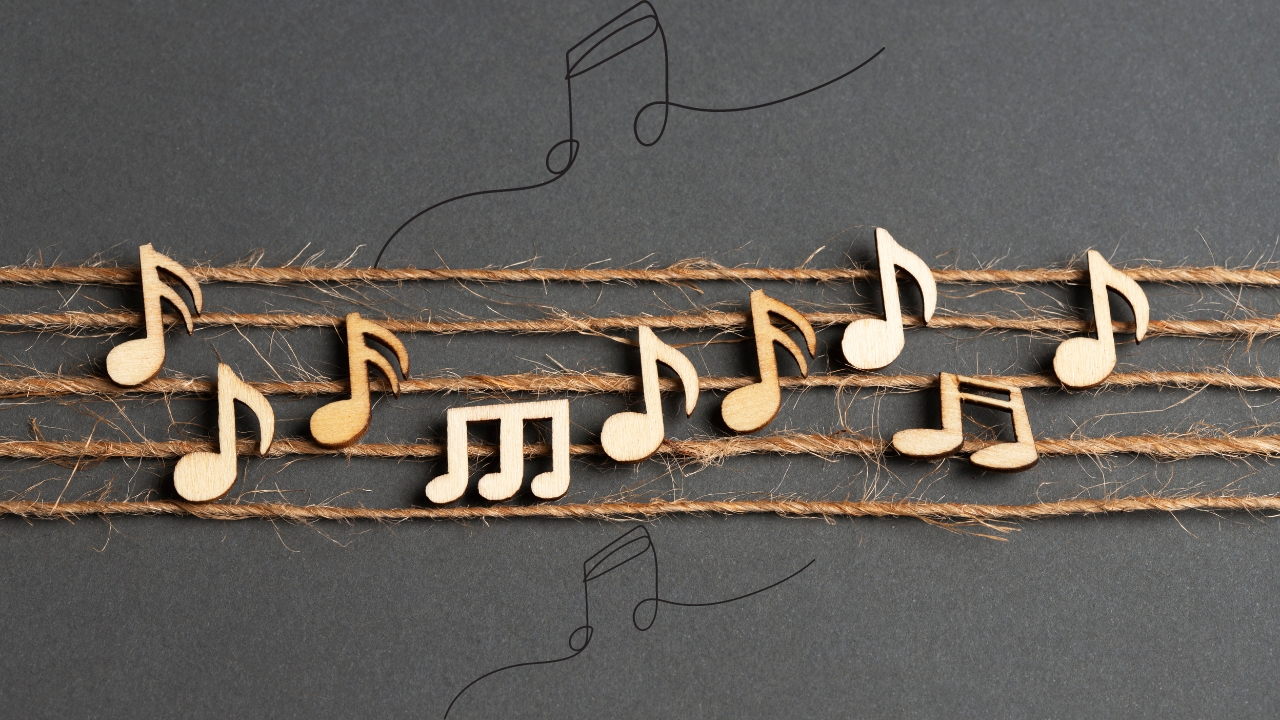The Ultimate List of Musical Terms
In the musical world, every piece of music is unique because each musician has a different style of composing. Musicians structure the elements of music in various ways according to the theme of the song they are creating. Understanding these differences begins with knowing the fundamental elements and terms of music. That’s why we’ve compiled the ultimate list of musical terms to get you started in the world of music.
Although there are many elements of music, twelve fundamental ones stand out that everyone should know about. Let’s dive in!
Accent
An accent refers to a stressed phrase, chord, or specific notes with a raised intensity above non-accented notes. It plays a key role in articulation and rhythm patterns during a musical performance.
Adagio
In Italian, Adagio signifies “slowly.” It instructs that a musical piece should be performed at a slower speed or tempo.
Allegro
Allegro signifies cheerfulness in Italian, meaning that the musical phase should be played at a fast or lively pace.
Alto
The term Alto indicates a pitch range typically assigned to a choir singer. It is lower than the Soprano range but higher than the Tenor range making its place in the list of musical terms.
Andante
Andante represents a moderately slow tempo, suggesting that the musical composition should be played at a walking pace.
Arpeggio
An Arpeggio occurs when the chords are broken and performed in sequence. It allows experimentation with chords and different note arrangements.
Bar
A Bar signifies a segment of time that corresponds to a particular number of beats. Each beat is represented by a specific note, with the bar’s boundary marked by vertical lines.
Cadence
A Cadence indicates the completion of a musical composition, represented by a particular set of notes.
Cadenza
A Cadenza offers performers the freedom to deviate from a strict rhythm or tempo, showcasing their musical skills during a brief period.
Canon
A Canon involves overlapping harmony played by one or multiple instruments, with repetition of a specific number of bars should be considered in the list of musical terms.
Clef
A Clef represents a scale of tones, marked at the beginning of a sheet of music as a symbol.
Coda
A Coda directs the orchestra to move to the beginning of the final passage, marking the start of each concluding section of a melody.
Crescendo
A Crescendo refers to a gradual increase in dynamic sound throughout a segment of music.
Da Capo
Da Capo instructs the group or symphony to restart the musical piece from the beginning and continue until the specified point.
Diminuendo
Diminuendo is the opposite of Crescendo, indicating a gradual decrease in dynamic sound during a segment of melody.
Dynamic
Dynamic refers to how loudly or softly different notes in a piece of music should be played. It varies depending on the theme or occasion for which the song is composed.
Fermata
A Fermata symbol on a music sheet indicates that a note should be sustained longer than its normal duration, at the discretion of the conductor or artist.
Flat
Flat indicates a note’s relative tonal variation, where the note is a half-step lower than the corresponding natural note getting it place in the making its place in the list of musical terms.
Fortepiano
Fortepiano refers to the sudden transition between loud and soft tones, directed by the performer.
Giocoso
A performance described as Giocoso is executed in a joyful and cheerful manner.
Glissando
Glissando involves gliding between various notes without emphasizing any particular tone, following a specified direction.
Glockenspiel
A Glockenspiel is an instrument similar to a xylophone, featuring metal strips attached to a solid rod and arranged in a scale of pitches from low to high.
Harmony
Harmony occurs when high and low pitch notes are played simultaneously, creating an appealing sound. Melody can exist without harmony, but harmony requires a melody and is very important in the list of musical terms.
Largo
Largo, also known as Larghetto, indicates a slow tempo in instrumental music. It suggests a broad, large movement.
Leggero
In a music sheet, Leggero indicates that the music should be played lightly, usually at a faster speed and with a cheerful tone.
Legato
Legato refers to the smooth introduction of new notes without distinct articulation within the notation.
Melody
Melody is the sequence of high and low pitch notes played one after the other to create a pleasing sound.
Motif
A Motif is a recurring theme or note pattern played with various other techniques.
Music Notation
Music Notation is the written expression of a song, including notes, tempo, timbre, and even genre.
Natural
A Natural note signifies that the tone is neither sharp nor flat, as indicated by the symbol on the music sheet.
Nonet
A Nonet is a group of nine musicians, each with a distinct role in a musical performance.
Ostinato
Ostinato refers to a pattern that repeats throughout the melody, similar to a Motif.
Pan
Pan describes the audio signal’s direction in stereo production, determining where the sound will be heard.
Pianissimo
Pianissimo indicates that the passage should be played very softly, quieter than Piano but louder than Pianississimo.
Pitch
Pitch describes how high or low a note or piece of music sounds making it a important part of list of musical terms.
Pizzicato
Pizzicato refers to plucking the strings of an instrument instead of bowing them.
Quarter Tone
A Quarter Tone is a pitch interval smaller than a semitone or whole tone.
Quintuplet
A Quintuplet instructs performers to play five notes in the time normally given to a quarter note.
Rhapsody
Rhapsody is a composition where segments flow freely without strict relation to each other.
Rhythm
Rhythm is the pattern of beats, notes, and silences that repeat at regular intervals in a piece of music.
Ritardando
Ritardando instructs the musician to gradually slow down the tempo of the music.
Rondo
Rondo is an arrangement of sounds and instrumental tones with recurring themes throughout the melody.
Scherzo
A Scherzo is a small, lively section of a complete musical piece.
Scale
A Scale is an ordered sequence of pitches in a song. The distance between two successive notes is called a scale step.
Sforzando
Sforzando places a strong emphasis on a note, requiring the performer to play it abruptly but in harmony with the surrounding notes.
Sharp Notation refers to a note that is a half-step higher in pitch than the corresponding natural note.
Soprano
Soprano represents the highest vocal range, above the Alto scale.
Sostenuto
Sostenuto notes require musicians to sustain each note beyond its standard value, as indicated on the music sheet.
Structure
Structure refers to how a piece of music is arranged, including its introduction, verses, pre-chorus, and chorus.
Tempo
Tempo is the speed at which a section of music should be performed, varying from slow to fast and also a important part of the list of musical terms.
Timbre
Timbre is the unique quality or color of a note’s sound.
Texture
Texture describes how a piece of music sounds when its tempo, melody, and harmony are combined, reflecting the overall quality of the composition.
Tenor
Tenor lies between the Bass and Alto ranges, representing a mid-range scale of notes.
Tremolo
Tremolo is a pattern of rapidly repeating the same note, creating a trembling effect.
Trill
A Trill involves rapid alternation between two different tones.
Vibrato
Vibrato is a technique where the pitch of a note oscillates rapidly between slightly higher and lower tones.
Vivace
Vivace indicates a fast pace, dynamic energy, and bright playing style.
Woodwind
Woodwind instruments are a family of wind instruments originally made of wood, such as the flute, clarinet, and oboe.
Xenakis
Named after composer Iannis Xenakis, Xenakis refers to the use of probability-based methods in music composition.
Xylophone
A Xylophone is a percussion instrument with wooden bars that are struck by mallets, each bar tuned to a specific pitch.
Yodel
Yodel is a form of singing that involves rapid pitch changes between the chest and head registers.
Yoke
A Yoke is a frame used to support a set of bells in bell ringing, often found in churches and cathedrals.
Zither
A Zither is a flat wooden instrument with strings stretched across it, played with fingers or a plectrum, primarily used in folk music.
Zydeco
Zydeco is a music genre that evolved in southwest Louisiana, blending blues, rhythm and blues, and indigenous music.
This list of musical terms will help you understand and create music on a professional level. By expanding your musical vocabulary, you can enhance your musical education. If your dream is to become a professional musician, you can make it a reality by connecting with Deliver My Tune. Our platform is a digital music aggregator that helps you release your music globally.
For further reading, explore these related articles:
- JioSaavn vs Spotify: A Comprehensive Comparison for Music Lovers in India
- Sell Your Events Ticket on Spotify – Maximize Your Ticket Sales
- How Long Does It Take for Music to Appear on Spotify?
For additional resources on music marketing and distribution, visit Deliver My Tune.






